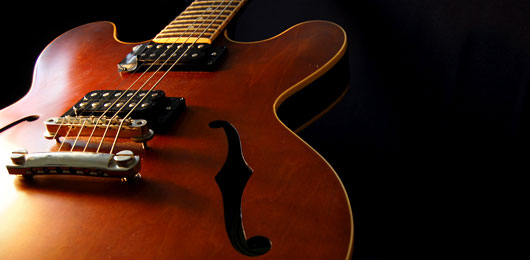So you've been dabbling in guitar since high school and you've just graduated college…What's that you say? You're ready to learn some more songs besides “Wonderwall” by Oasis and “Blister in the Sun” by the Violent Femmes? Well, you don't have to be a pro musician to have a real guitar. Put away that Mexican-made Samick TM “strat”, here's a crash course on taking it to the next level without breaking your bank:
How to Buy Your First Guitar
By Matt Miller
Spend Some Money.
The investment is worth it. If you pick the right guitar it could last you your entire life. Start at a minimum of $500. Make a commitment to your decision. They always say that acoustic guitars become more resonant as they age. If you're looking to go acoustic, get a nice one and it'll repay you as the years go by.
Guitar Brands — What's in a Name?
A-fucking-lot. There are so many different brands out there but only a handful of trusty ones. Let's start with the obvious. On the electric side, there's Gibson, Epiphone and Fender. Keith Richards (Gibson ES-335, Fender Telecaster), B.B. King (Gibson ES-335 “Lucille”), John Lennon (Epiphone Casino), Eric Clapton (Gibson ES-335, Fender Stratocaster, Gibson SG), and Jimi Hendrix (Fender Stratocaster) knew having a guitar from a trusted brand is important.
There's a reason these brands have been so prominent for the past 70 years. They make great guitars with great tones that last.
On the acoustic side (for those of you looking to get some panties wet), we've got Martin, Taylor, Gibson and Epiphone. Many people look at Martin and Taylor guitars as the best in the acoustic guitar arena. Reason being, Martin and Taylor have focused on acoustic guitars for many years while Gibson and Epiphone have a much wider range of products. This can be deceiving though. Gibson acoustic guitars have been played for over 60 years by some of the greatest ever. Names include Elvis, Woody and Arlo Guthrie, Bob Dylan and Pete Townshend. Epiphone players include Paul McCartney and Peter Frampton.
God Bless America
Forget Mexico and Japan, when it comes to making guitars, America is #1. (Insert John Mellencamp lyric here.) Before you call me a xenophobe, see if you can ever remember hearing a story about Slash driving down to Tijuana to pick up the brand new Gibson custom shop Les Paul. Neither can I. The fact of the matter is, if you want a lasting guitar, make sure it was made in the ole U S of A.
We are Living in a Material World
The type of wood/materials that the guitar is made out of have an effect on its overall sound. Let's get you familiar with the standard wood types of an electric guitar just so when you're talking to Ed over at Sam Ash you'll at least sound like you know what you're talking about. Generally, the body, neck and fingerboard are made up of different woods. My pride and joy (Gibson ES-333) has a mahogany with a rosewood fingerboard. Mahogany gives the guitar a warmer, fatter tone. Most Fenders traditionally have a maple neck which gives it a brighter, stronger tone. It's easy to hear. Play a Fender Stratocaster next to a Gibson 335 and you'll hear a huge difference. Part of that is in the materials made and part of it is in the pickups.
The two standard kinds of pickups are a single coil and a humbucker. They definitely have different tones and there are many different types of each. The single coil is the pickup commonly seen on an Fender Stratocasters and Telecasters. It looks like one bar. Single coils also come in the P-90 variety which have brighter tones (often seen on the Epiphone Casino). Humbuckers are basically two single coil pickups put together. Sometimes they look like two single coils placed next to each other and other times they have a metal cover over them. Remember the name “Alnico” when it comes to humbuckers. They are trusty and not too expensive.
Ok, enough jibber-jabber…
Test Drive Your Ax
Before making a final decision, go to the store and play the shit out of the guitar. You'll feel it when you find the right one. There are so many factors when it comes to guitars (see previous two convoluted paragraphs) but if it sounds right and feels right, it is right. This is one of the most important parts of the whole process. Now, you don't have to grow your hair long, put on black clothes, walk into Guitar Center, turn an amp up all the way and play Slayer on the show room floor for two hours…but you do need to feel its potential in your hands. If you're looking to slay rock demons with your axe, you need to learn how to swing it.
One last thing to keep in mind is if you're looking to play electric guitar, spend some time looking at amps. A $2000 electric guitar through a $100 8 inch speaker isn't going to cut it. You don't need a wall of speakers, especially if you don't have plans to ever really play out in clubs, but you do need something with a warm tone that will be rewarding when you play through it. I would suggest a tube amp with a minimum of one 12 inch speaker. An example of a great, decently-priced amp is the Fender Blues Junior (tube amp, one 12 inch).
Bottom line, take care in your decision and be willing to spend some money. Look, there are no rules when it comes to music because it comes down to how we feel about the sounds we make.
Oh and if you're left-handed, good luck, I feel your pain…
Matt Miller is currently a performing songwriter in Los Angeles, CA. Check out his music at www.myspace.com/mattmiller or www.mattmillermusic.com.


















